How To Make Knife Sheath Template
in: Featured, How To, Skills
• September 10, 2013 • Last updated: June 2, 2021
How to Make a Sheath for a Knife (Or Anything Else)
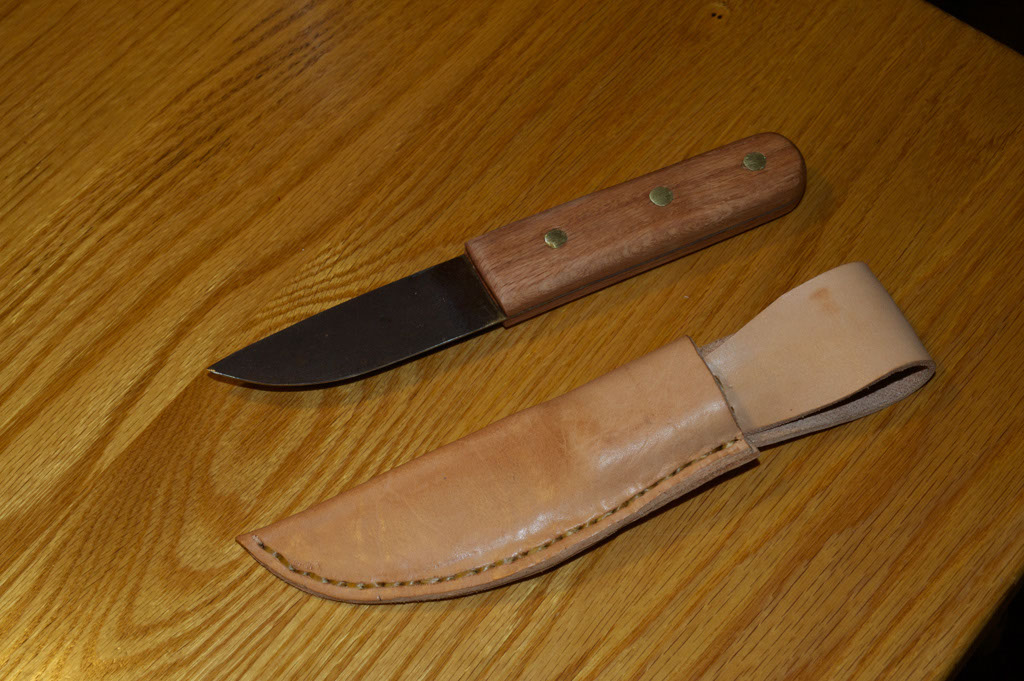
Sometimes you want an particular close at hand: non in a pocket, only correct at that place where you lot need it. A pocket lookout, compass, pocketknife, cell phone, or any other item you don't want to dig for are all great candidates for a leather sheath. You lot might want to make something to hold a multi-tool or any specialized tool you may want to proceed handy at all times. If y'all're a widget lover and tin't detect a case for your widget, only substitute widget wherever it says knife.
This article is useful for the knife you (might take) made, just likewise teaches the method of moisture-shaping leather. When saturated, leather tin be stretched and molded to fit different objects.
Materials and Tools
- Leather, medium weight (five to 6 ounces)
- Rotary cutter or X-Acto knife
- Pencil
- Paper-thin from file folder
- Rowel cycle
- Fid
- Groover tool
- Waxed artificial sinew or thread
- Leather-stitching needles
- Pie pan of water
- Jump clips
- Saran wrap
- Tape
- Dishtowel
How to Brand a Leather Sheath
Footstep one: Draw Your Pattern
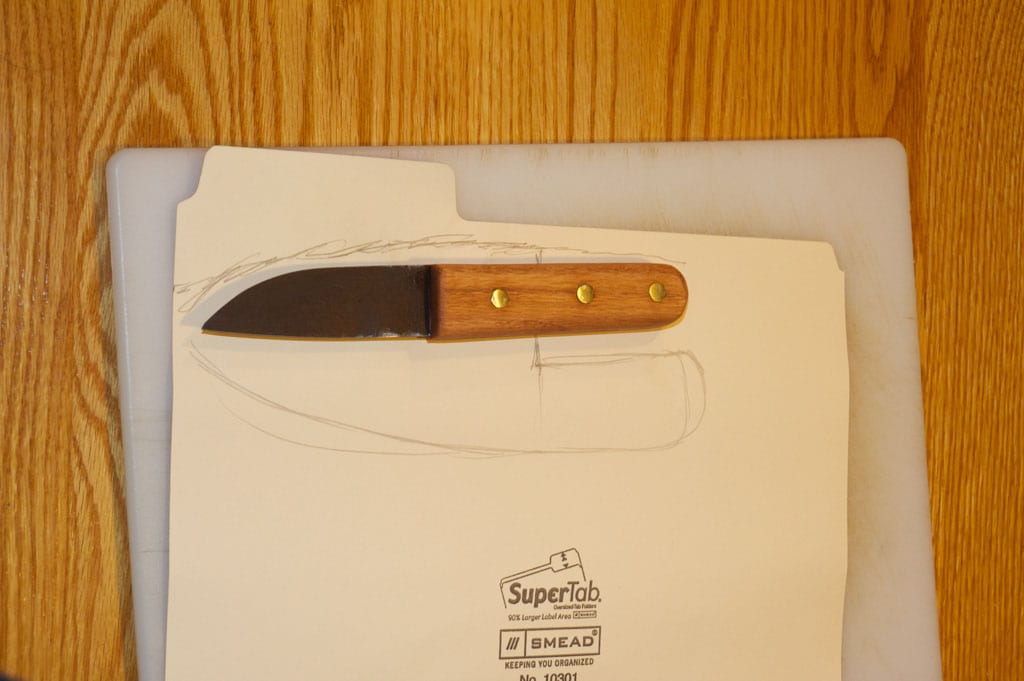
Lay the knife out on your piece of cardboard and roughly trace around the blade and equally much of the handle as yous want to cover with your sheath. The design is not symmetrical, every bit the back of the sheath has an extension that ultimately will be folded down and stitched in place to make a loop through which your belt will exist threaded. Again, this doesn't accept to be perfect, and better as well large than too modest.
Step 2: Cut Out and Gather Your Pattern
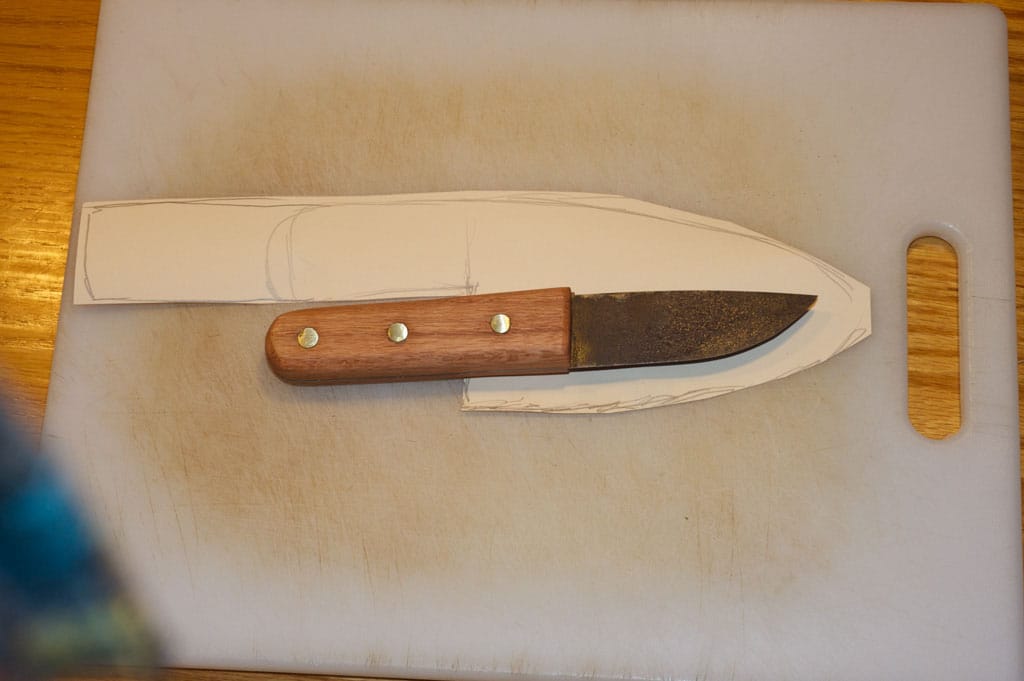
Using a scissors, practice a rough cut to see how your pattern looks when the knife is laid out.
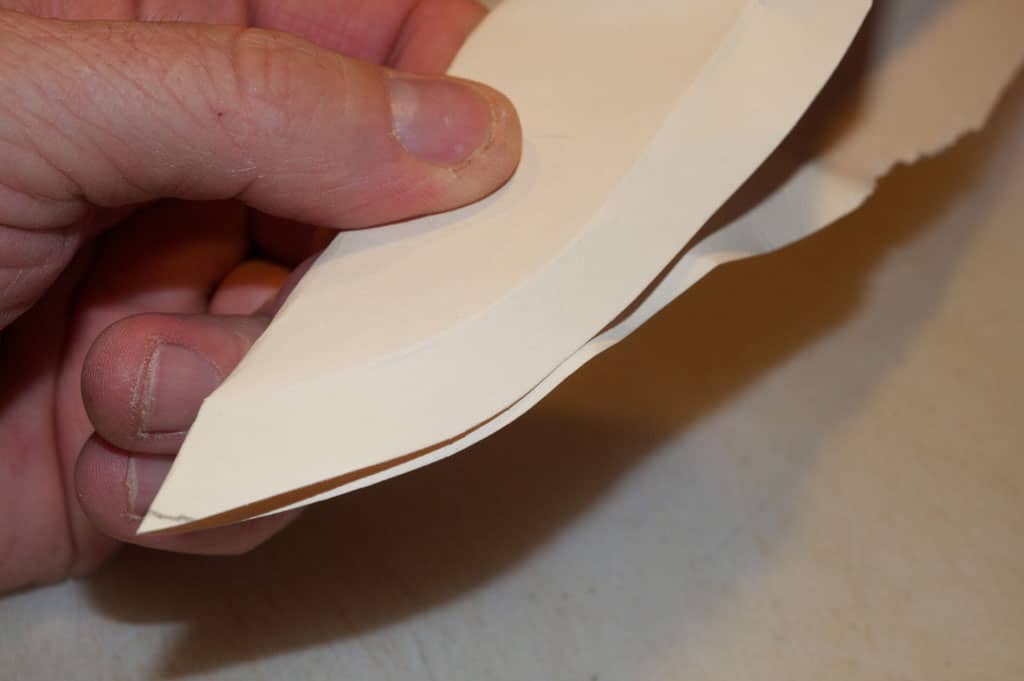
If you're happy with it, fold the pattern in half along the line that will make the back of the blade part of the sheath and trim the overlap so the pattern is symmetrical. Push the paper confronting the blade to meet where information technology lies inside the pattern. Yous can see in the photo a slight crease in the paper-thin, which shows plenty of clearance between the edge of the cardboard and the blade.
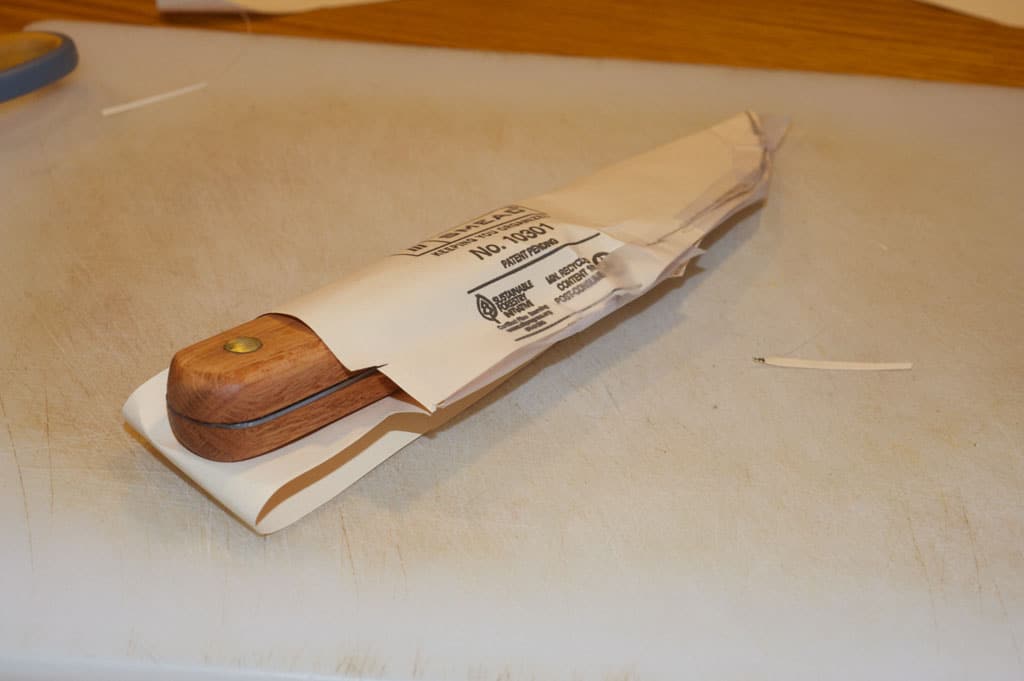
Adjacent, use a picayune bit of agglutinative record to actually make the pattern the same three-dimensional shape as your leather will be. This allows you to make adjustments now while it's easier.
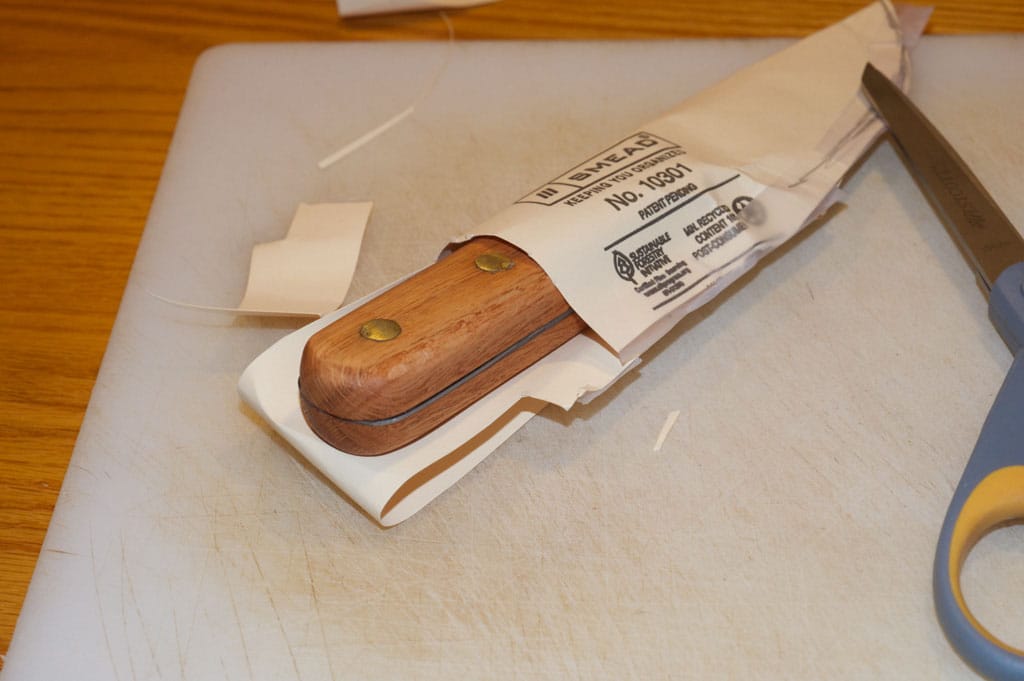
You can meet that I accept trimmed back the design to even it out and give the handle a little more than exposure. A little more trimming and nosotros'll exist fix to cut out the actual sheath leather. Cut the record holding your pattern together, and flatten it out.
Stride iii: Trace and Cutting Your Piece of Leather
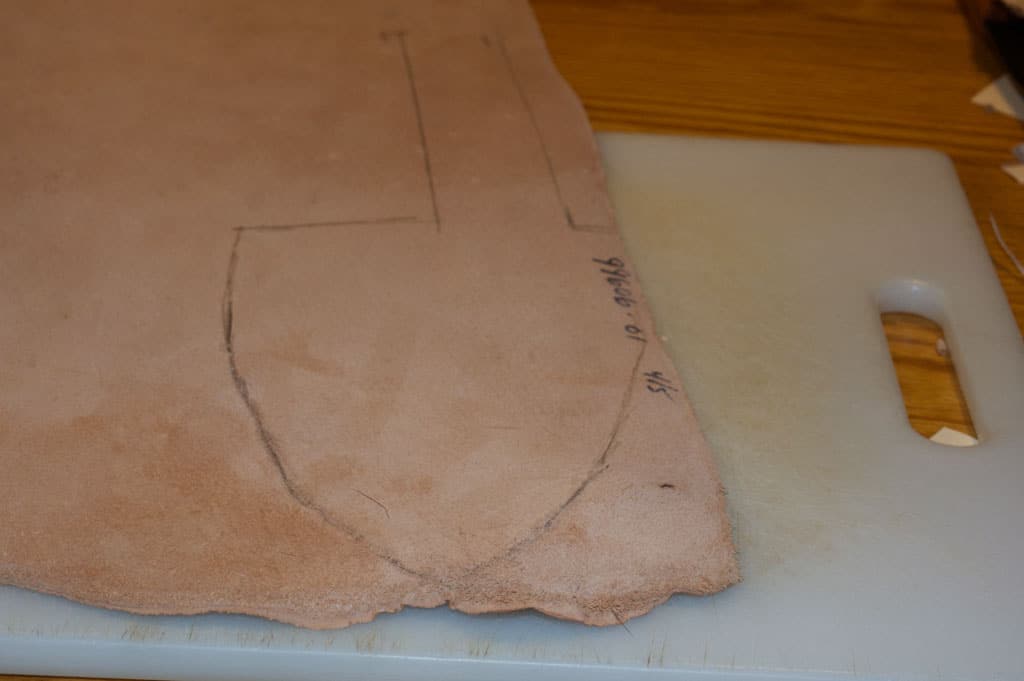
Trace your pattern onto the incorrect side of the leather (the fuzzy suede office). This is because a) information technology's easier and b) information technology sets upward the belt loop so the right side is facing forwards. I tend to ignore the chugalug loop section of the pattern and use it just as a guide to trace a long piece using a ruler to make sure information technology'south long enough and straight.
Cut out your leather using a rotary cutter, but practise not cut into the inside corners where the bract part of the sheath meets the chugalug loop, equally you lot will over-cutting and make unsightly nicks. Stop short of those spots and use an Ten-Acto or sharp knife to finish the cuts.
Step four: Starting time Forming the Leather

Wrap whatever your particular is in plastic wrap, using enough of it, and tape to tuck everything in nicely.
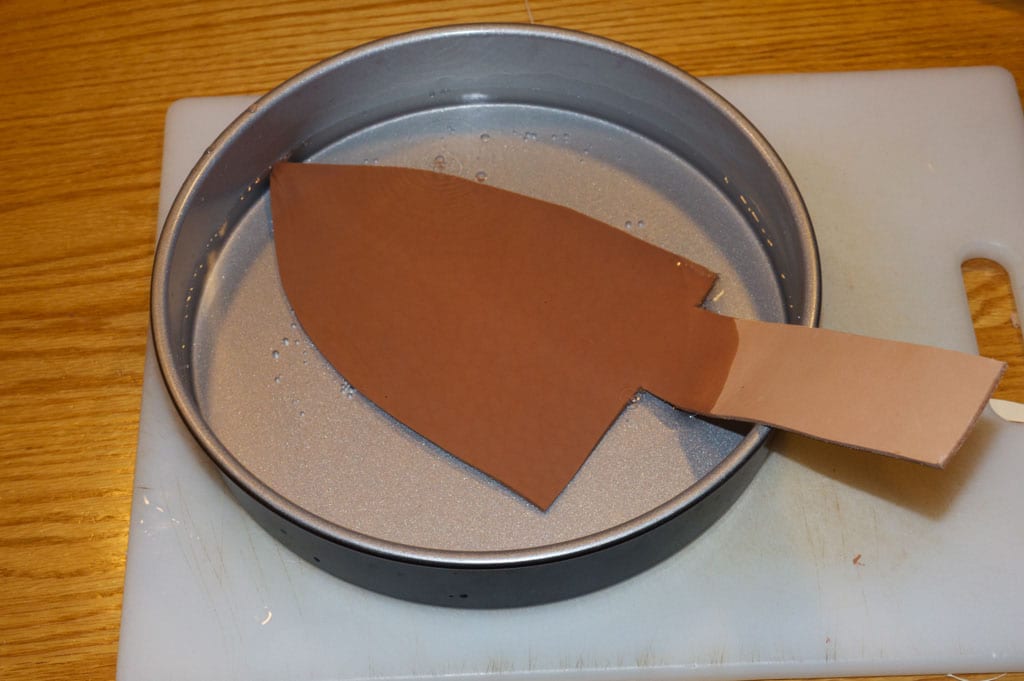
Gather your dishtowel, item to exist sheathed, a pan of hot tap water, and your spring clips. Identify the sheath role of your leather in the hot h2o. Information technology will change colour and bubble a picayune equally the water seeps into the leather. Just a few minutes is plenty.
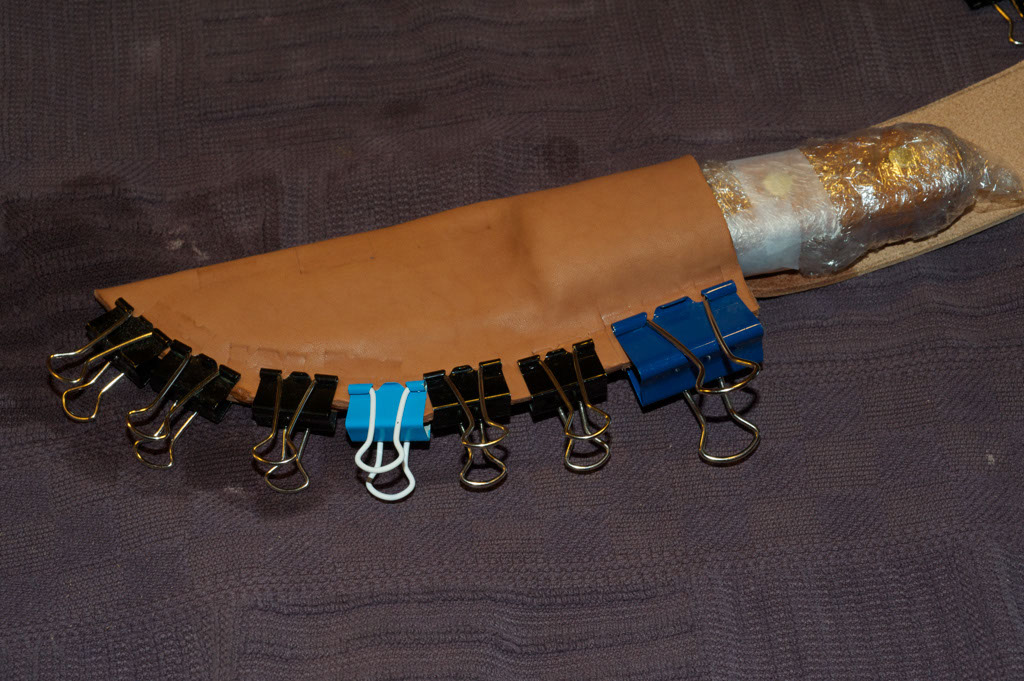
Identify your leather on the dishtowel and fold the towel over on the leather and push down to pat it dry and squeeze out the excess water. Place the knife on your leather and fold it over, forming it over the handle as y'all go. Using spring clips, clamp the leather in place and work the leather then information technology forms naturally around the blade and handle. You lot tin class the leather with your fingers so it hugs the handle. Set up it bated to dry out, only I usually bank check it every v minutes for the first half hour to brand sure the leather is moulding the way I want it to.
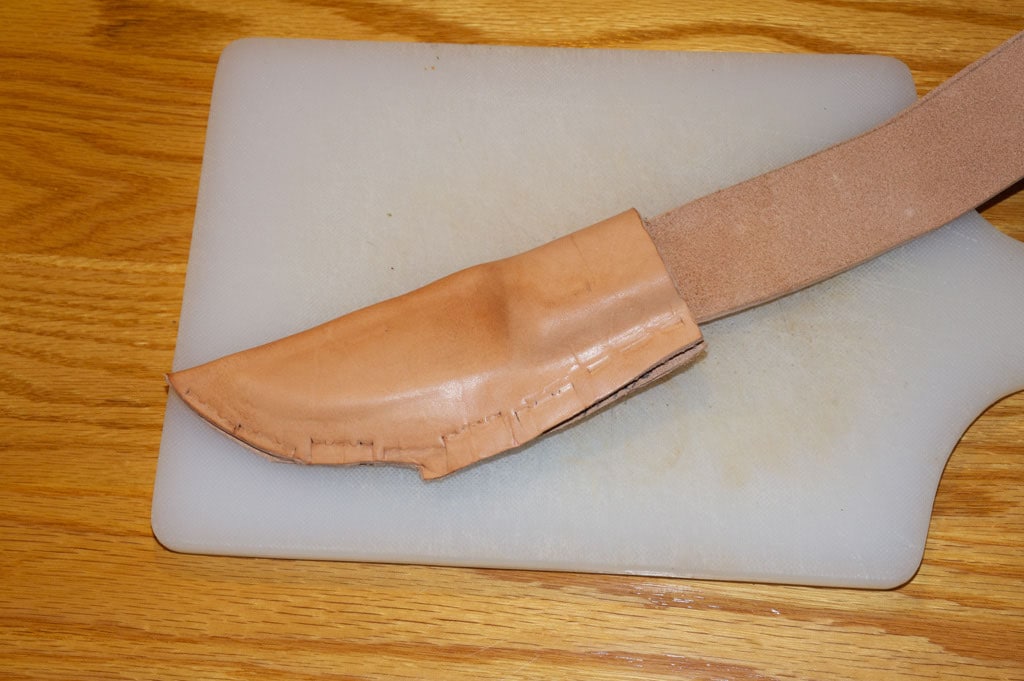
You tin piece of work with your leather once more after several hours (depending on the heat and humidity) or go out it overnight. When the leather is dry, remove the spring clips and you lot'll be left with a sheath "husk."
Step five: Trim the Sheath and Prepare to Stitch the Seam
Using the rotary cutter, trim the sheath to size by taking off the rough edges and following the contour of the blade and handle. You're cutting through two layers of leather that has been water-hardened so it'll take a picayune more pressure. Get ho-hum and don't cutting yourself.
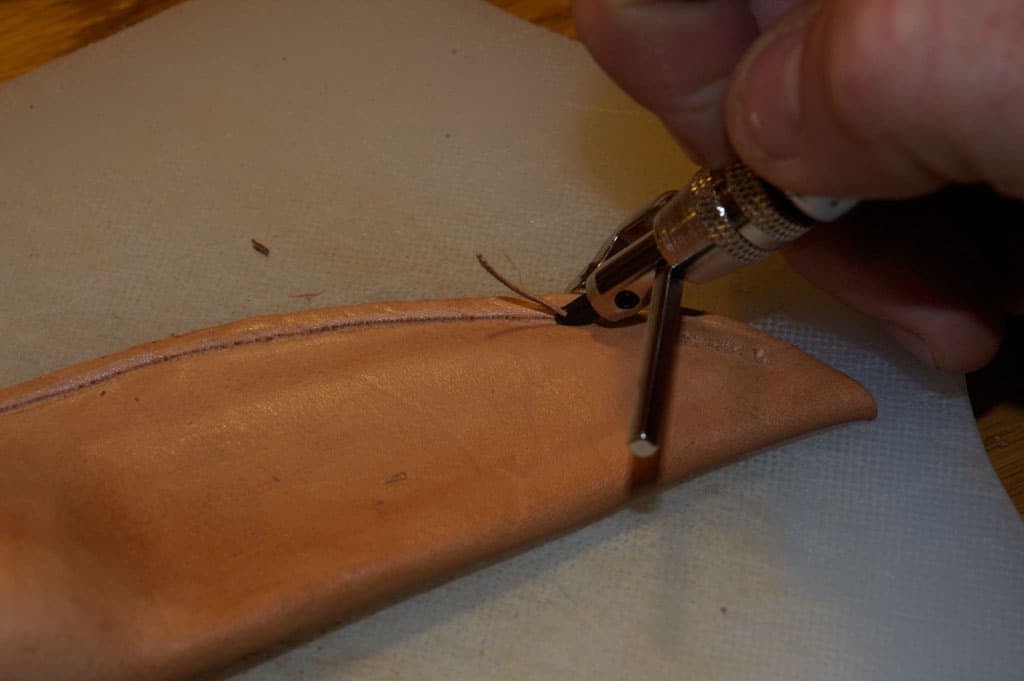
Using a leather gouge, cut a shallow groove into the leather following the edge of the sheath seam. You can do this freehand or use a gouge with a built-in guide.

Marker your stitches in the groove using a rowel tool. Six holes per inch is fine. If you lot don't have a rowel tool, you lot can do it freehand and go ho-hum and careful-like.
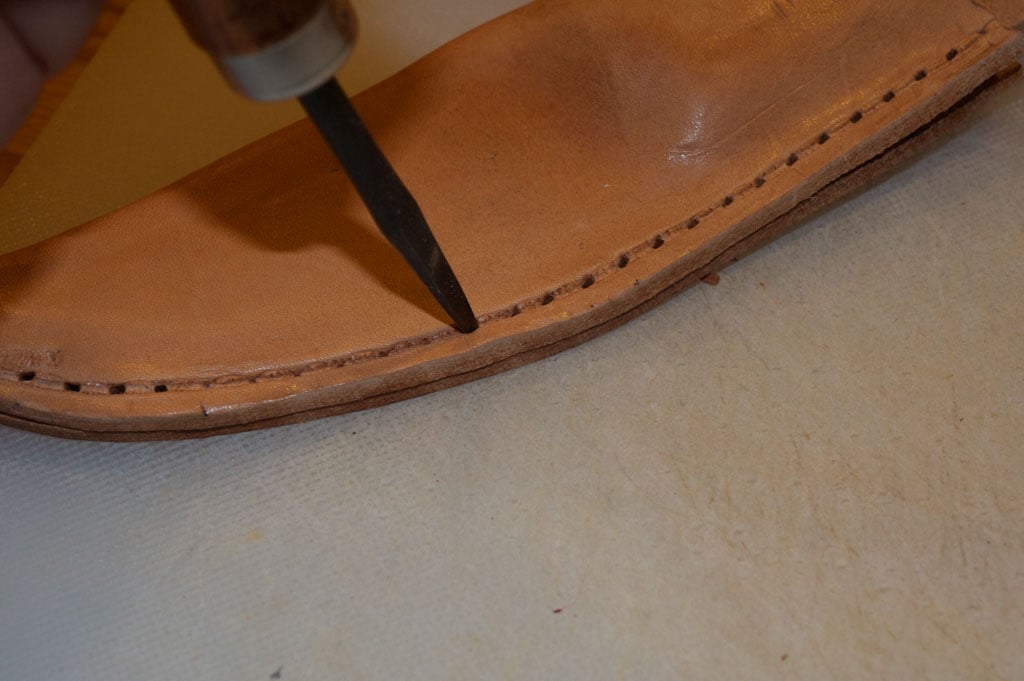
Place your sheath on a plastic cut board and using your fid, create holes in the indentations y'all made with your rowel tool. Use a pocket-size mallet and tap your fid lightly. In one case y'all have poked all your holes, lift the top layer of the sheath and exercise the same matter on the bottom, equally your fid will have started holes on the lesser layer too. Make sure they line up or your stitching volition not exist fun. If you do non take a fid, you lot can use an ice pick or other pointy matter. Fids work a piddling better because they make a modest slit, not a hole.
Pace 6: Stitch the Belt Loop in Identify
It'due south much easier to run up the chugalug loop now before stitching up the sheath. Fold your belt flap over to the front and adjust it so information technology'south the size you lot want, and trim it to size. It should fasten just below the pinnacle of the sheath. Any deeper and you may see bug with the handle not seating well in the sheath.
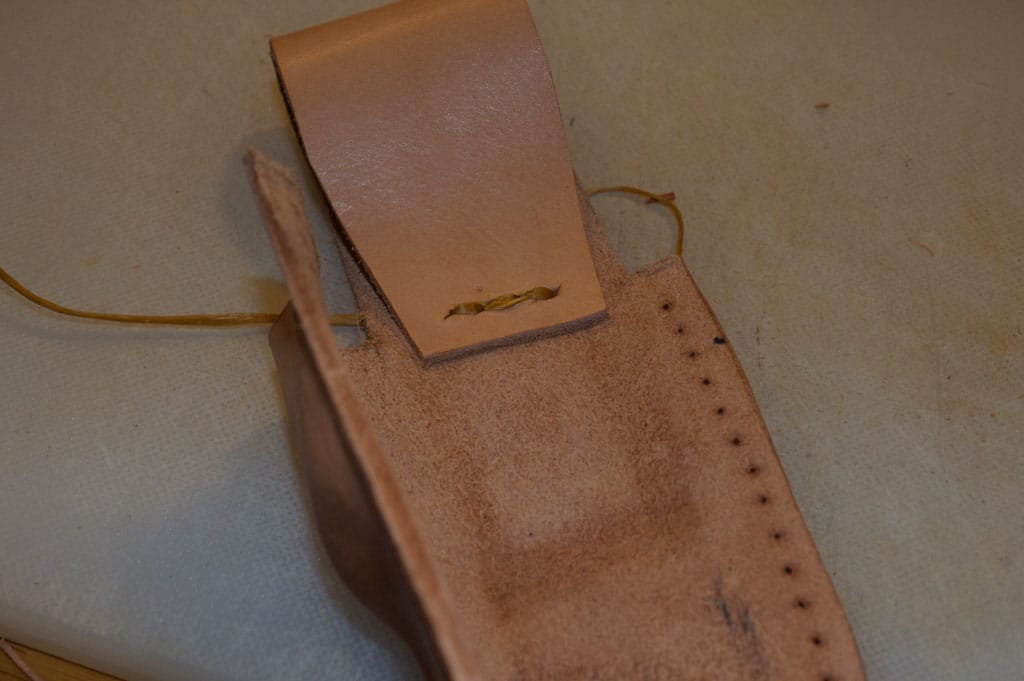
Using your four-prong dial, make a row of holes in both the end of the belt loop and the superlative of the sheath equally shown. If you don't take a leather punch, you can use a fid or ice pick or anything abrupt and pointy. Trim backlog leather, if whatsoever, off the cease of the strap. Using your needle and bogus sinew, stitch the loop, going in and out until you take three stitches showing. Tie off your thread and cut your sinew close to the knot.
Footstep seven: Sew the Seam
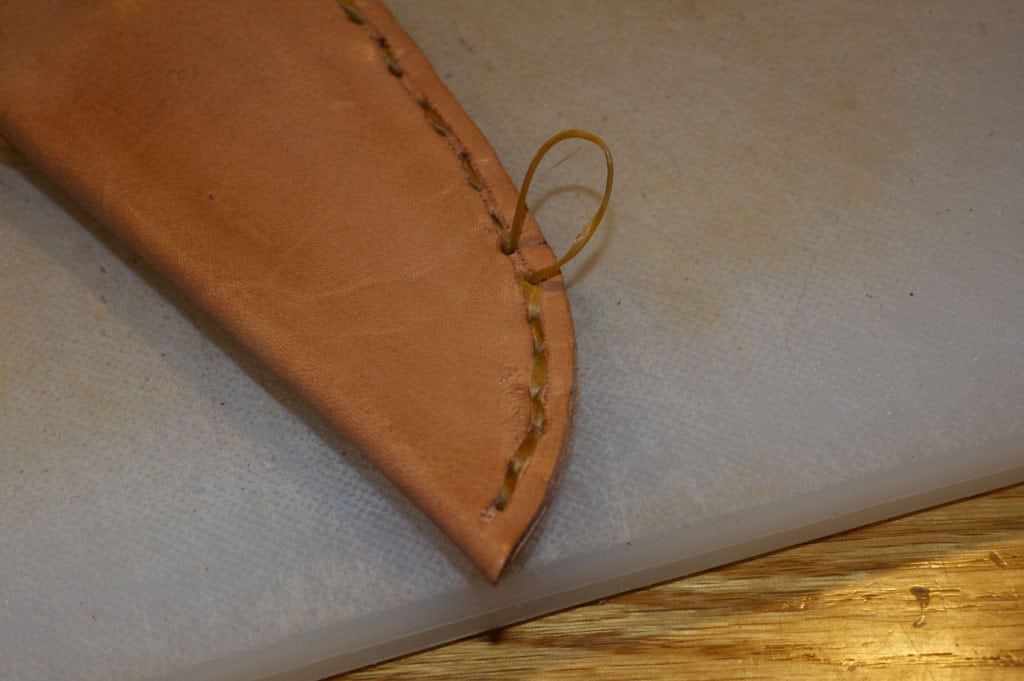
Using a single needle and sinew, get-go sewing from the bottom of the slice near the top of the sheath. Stitch the side going up through the leather and downwards through the next hole. You could utilise a double needle technique hither, but for such a short seam, a single needle technique is fine.
Once you reach the tip of your sheath, plough around and become up from the lesser, doing the opposite of what you merely did. The issue is to create a stitch that will not unravel, and with the groove in the leather, the thread is protected and sits flush or below the surface of the leather. Necktie off your knots, then thread your needle in and out the finish holes a few times, finishing by threading the needle through one layer of leather and then pull tight. Cutting the lacing flush with the seam and it will be hidden.
Using the wooden terminate of your fid, burnish the seam of your sheath to even out the stitching and push button the stitches down into the sheath.
Stride eight: Insert Knife or Other Object
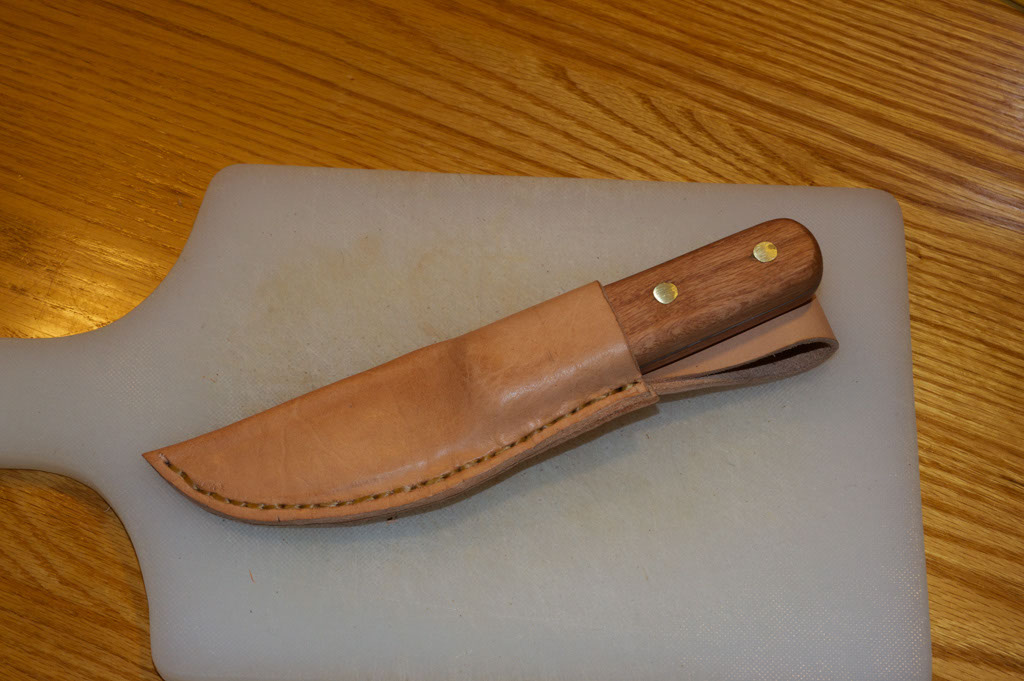
Insert your knife. It should be just a bit snug — it volition loosen merely a petty bit over time. Put it on your belt. Revel in the knowledge you fabricated something cool.
Previous Side by side
How To Make Knife Sheath Template,
Source: https://www.artofmanliness.com/skills/how-to/how-to-make-a-sheath-for-a-knife-or-anything-else/
Posted by: woodbeetch.blogspot.com


0 Response to "How To Make Knife Sheath Template"
Post a Comment